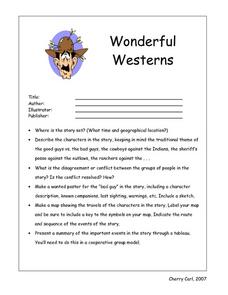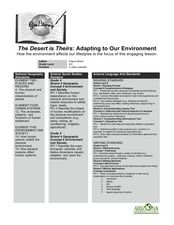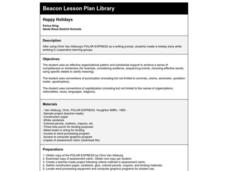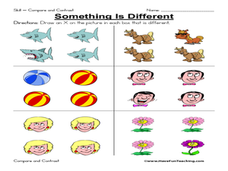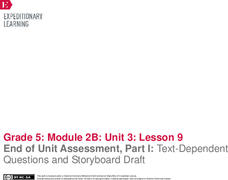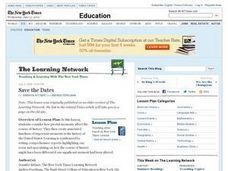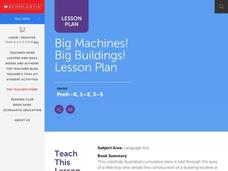Curated OER
Language Arts: Plotting Stories
Second graders read the story, "The Foolish, Timid Rabbit," as part of a unit on appearances. After reading with partners, they write their own stories that include elements about some forms of matter from their science studies. Students...
Curated OER
Writing
Young scholars practice word processing skills while writing Haiku and diamonte poems. In this poetry computer lesson, students choose from a group of rainforest animals and write about their animal. Young scholars write a narrative...
Curated OER
To Kill a Mockingbird: A Historical Perspective
Students research the Great Depression. In this Great Depression lesson plan, students analyze primary sources to develop an understanding of life in the American south during the depression era as they read Harper Lee's To Kill a...
Curated OER
Legends Old and New
Young scholars listen to a Native American legend and discuss the basic elements of story. In small groups they read and analyze more legends from books and Websites. Then they compose and present an original legend.
Curated OER
Ramona Quimby, Age 8
Third graders read Beverly Cleary's book "Ramona Quimby, Age 8" and then complete a series of extension activities. Students explore cause and effect, sequencing, related websites, grammar lessons and comparison skills.
Curated OER
Wonderful Westerns
In this book report worksheet, students choose a novel about westerns to read and then completes six various assignments dealing with the novel of their choice.
Curated OER
Nibble, Nibble, Little Mouse
Students complete activities to analyze points of view in different texts. In this point of view lesson, students read Hansel and Gretel and The Magic Circle and discuss the points of view. Students choose a character from the story and...
Curated OER
The Desert is Theirs: Adapting to Our Environment
Young scholars determine how animals and people adapt to the desert environment. In this desert lesson, students review vocabulary about the desert and how humans have to make changes to accommodate their environments. They listen to and...
Curated OER
Happy Holidays
Students create holiday story while working in cooperative learning groups, using Chris Van Allsburg's Polar Express as a writing prompt.
Curated OER
Four Square Facts
Second graders play a game of Four Square. They recall the events of a story in order as they pass the ball in order around the square. Play ends once students have performed the story for the teacher.
Curated OER
Essential Narrative Concepts
Students interact with the main concepts of a narrative text in the six lessons of this unit. The setting, prediction, retelling, sequencing, and the identification of the beggining, middle and end of a story are investigated.
Curated OER
Go Go Gumbo
Students read the book, "Go Go Gumbo." After looking the front and back cover, students predict what may happen in the story. They discuss strategies for reading unfamiliar words. Students answer questions about the story. Cross...
Curated OER
An Amazing Story
Students develop sequential stories to guide a partner through a computer-generated maze. In pairs they illustrate each place and character listed, build and print a maze, and write a class-generated story.
Curated OER
Something is Different: Same/Different
In this different/same worksheet, student draw an X on the picture in a box that is different from the others, 6 sets total. A reference web site is given for additional activities.
Curated OER
Read Research and Report
Third graders organize information from fiction and nonfiction trade books to add to the understanding of a /curricular topic. They prepare oral presentations that reflect their understanding, show organization and include appropriate...
Johnson County Community College
Treasured Stories by Eric Carle
Explore the works of Eric Carle with a set of four lessons focused around the stories, Brown Bear, Brown Bear, What Do You See?, Papa, Please Get the Moon For Me, and The Very Hungry Caterpillar. Young readers develop a storyboard,...
EngageNY
End of Unit Assessment, Part 1: Text-Dependent Questions and Storyboard Draft: “You Can Do a Graphic Novel” Excerpt
Eyes on the finish line. Serving as the first part of the end of unit assessment, learners answer questions based on a text about how to write a graphic novel. Using what they've learned, they then create a storyboard about the invention...
Curated OER
Making Instant Whip (Recipe)
In this language arts worksheet, learners practice sequencing, finding action words and following directions as they make Instant Whip ( a dessert). Students cut picture cards and sequence the steps, then read the recipe and make the...
Curated OER
How Does a Pumpkin Grow and Glow?
Pupils write sequence of events needed to produce a carved jack-o-lantern.
Curated OER
The Very Clumsy Click Beetle
Second graders determine what it means to be clumsy before listening to Eric Carle's, The Very Clumsy Click Beetle. They examine the part where the click beetle does flips before drawing three frames that show the beetle flipping. For...
Curated OER
Save the Dates
Students create annotated timelines of important moments in the history of the United States. They write a report highlighting one event and predicting how the history might have been different had the event not occurred.
Curated OER
Freedom Train North
Fourth graders conduct a novel study of the book Freedom Train North. They identify the parts of a story that include beginning, middle, and end. Students also recognize the setting, plot, and theme after reading a part of the book daily.
Curated OER
Big Machines! Big Buildings! Lesson Plan
Students read a book and understand the cumulative events of the story through sequencing. In this lesson about cumulative texts, students are able to read the story and understand the sequence of the events. Students listen to the...
Curated OER
Cause And Effect
Fourth graders read the book Stellaluna and cite sentences that show cause and effect in the story. In this cause and effect lesson plan, 4th graders also write sentences that show cause and effect in their own lives.







